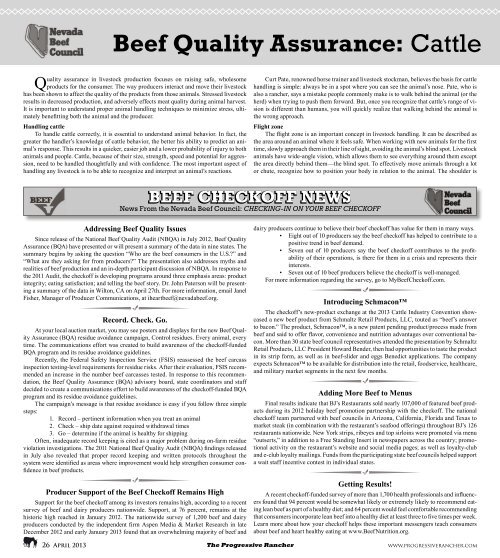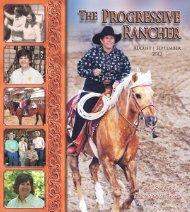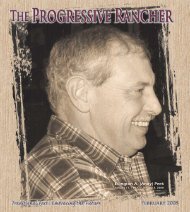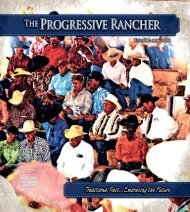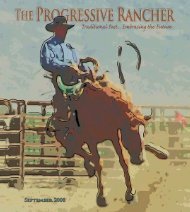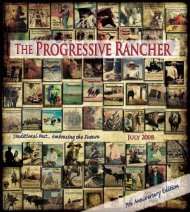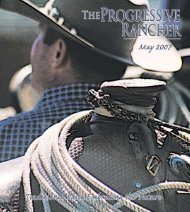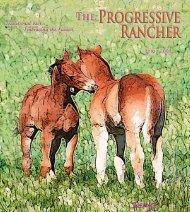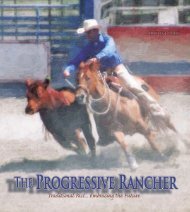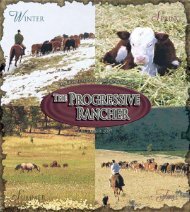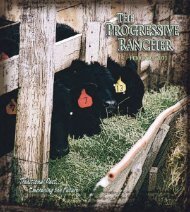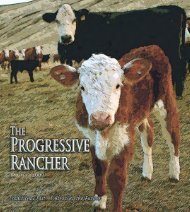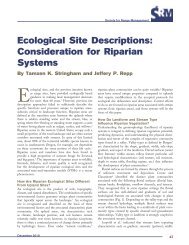NCA 2009 President's Award Recipient - The Progressive Rancher ...
NCA 2009 President's Award Recipient - The Progressive Rancher ...
NCA 2009 President's Award Recipient - The Progressive Rancher ...
Create successful ePaper yourself
Turn your PDF publications into a flip-book with our unique Google optimized e-Paper software.
Beef Quality Assurance:<br />
Cattle<br />
Quality assurance in livestock production focuses on raising safe, wholesome<br />
products for the consumer. <strong>The</strong> way producers interact and move their livestock<br />
has been shown to affect the quality of the products from those animals. Stressed livestock<br />
results in decreased production, and adversely effects meat quality during animal harvest.<br />
It is important to understand proper animal handling techniques to minimize stress, ultimately<br />
benefitting both the animal and the producer.<br />
Handling cattle<br />
To handle cattle correctly, it is essential to understand animal behavior. In fact, the<br />
greater the handler’s knowledge of cattle behavior, the better his ability to predict an animal’s<br />
response. This results in a quicker, easier job and a lower probability of injury to both<br />
animals and people. Cattle, because of their size, strength, speed and potential for aggression,<br />
need to be handled thoughtfully and with confidence. <strong>The</strong> most important aspect of<br />
handling any livestock is to be able to recognize and interpret an animal’s reactions.<br />
Curt Pate, renowned horse trainer and livestock stockman, believes the basis for cattle<br />
handling is simple: always be in a spot where you can see the animal’s nose. Pate, who is<br />
also a rancher, says a mistake people commonly make is to walk behind the animal (or the<br />
herd) when trying to push them forward. But, once you recognize that cattle’s range of vision<br />
is different than humans, you will quickly realize that walking behind the animal is<br />
the wrong approach.<br />
Flight zone<br />
<strong>The</strong> flight zone is an important concept in livestock handling. It can be described as<br />
the area around an animal where it feels safe. When working with new animals for the first<br />
time, slowly approach them in their line of sight, avoiding the animal’s blind spot. Livestock<br />
animals have wide-angle vision, which allows them to see everything around them except<br />
the area directly behind them—the blind spot. To effectively move animals through a lot<br />
or chute, recognize how to position your body in relation to the animal. <strong>The</strong> shoulder is<br />
BEEF CHECKOFF NEWS<br />
News From the Nevada Beef Council: CHECKING-IN ON YOUR BEEF CHECKOFF<br />
Addressing Beef Quality Issues<br />
Since release of the National Beef Quality Audit (NBQA) in July 2012, Beef Quality<br />
Assurance (BQA) have presented or will present a summary of the data in nine states. <strong>The</strong><br />
summary begins by asking the question “Who are the beef consumers in the U.S.?” and<br />
“What are they asking for from producers?” <strong>The</strong> presentation also addresses myths and<br />
realities of beef production and an in-depth participant discussion of NBQA. In response to<br />
the 2011 Audit, the checkoff is developing programs around three emphasis areas: product<br />
integrity; eating satisfaction; and telling the beef story. Dr. John Paterson will be presenting<br />
a summary of the data in Wilton, CA on April 27th. For more information, email Janel<br />
Fisher, Manager of Producer Communications, at iheartbeef@nevadabeef.org.<br />
Record. Check. Go.<br />
At your local auction market, you may see posters and displays for the new Beef Quality<br />
Assurance (BQA) residue avoidance campaign, Control residues. Every animal, every<br />
time. <strong>The</strong> communications effort was created to build awareness of the checkoff-funded<br />
BQA program and its residue avoidance guidelines.<br />
Recently, the Federal Safety Inspection Service (FSIS) reassessed the beef carcass<br />
inspection testing-level requirements for residue risks. After their evaluation, FSIS recommended<br />
an increase in the number beef carcasses tested. In response to this recommendation,<br />
the Beef Quality Assurance (BQA) advisory board, state coordinators and staff<br />
decided to create a communications effort to build awareness of the checkoff-funded BQA<br />
program and its residue avoidance guidelines.<br />
<strong>The</strong> campaign’s message is that residue avoidance is easy if you follow three simple<br />
steps:<br />
1. Record – pertinent information when you treat an animal<br />
2. Check – ship date against required withdrawal times<br />
3. Go – determine if the animal is healthy for shipping<br />
Often, inadequate record keeping is cited as a major problem during on-farm residue<br />
violation investigations. <strong>The</strong> 2011 National Beef Quality Audit (NBQA) findings released<br />
in July also revealed that proper record keeping and written protocols throughout the<br />
system were identified as areas where improvement would help strengthen consumer confidence<br />
in beef products.<br />
Producer Support of the Beef Checkoff Remains High<br />
Support for the beef checkoff among its investors remains high, according to a recent<br />
survey of beef and dairy producers nationwide. Support, at 76 percent, remains at the<br />
historic high reached in January 2012. <strong>The</strong> nationwide survey of 1,200 beef and dairy<br />
producers conducted by the independent firm Aspen Media & Market Research in late<br />
December 2012 and early January 2013 found that an overwhelming majority of beef and<br />
dairy producers continue to believe their beef checkoff has value for them in many ways.<br />
• Eight out of 10 producers say the beef checkoff has helped to contribute to a<br />
positive trend in beef demand.<br />
• Seven out of 10 producers say the beef checkoff contributes to the profitability<br />
of their operations, is there for them in a crisis and represents their<br />
interests.<br />
• Seven out of 10 beef producers believe the checkoff is well-managed.<br />
For more information regarding the survey, go to MyBeefCheckoff.com.<br />
Introducing Schmacon<br />
<strong>The</strong> checkoff’s new-product exchange at the 2013 Cattle Industry Convention showcased<br />
a new beef product from Schmaltz Retail Products, LLC, touted as “beef’s answer<br />
to bacon.” <strong>The</strong> product, Schmacon, is a new patent pending product/process made from<br />
beef and said to offer flavor, convenience and nutrition advantages over conventional bacon.<br />
More than 30 state beef council representatives attended the presentation by Schmaltz<br />
Retail Products, LLC President Howard Bender, then had opportunities to taste the product<br />
in its strip form, as well as in beef-slider and eggs Benedict applications. <strong>The</strong> company<br />
expects Schmacon to be available for distribution into the retail, foodservice, healthcare,<br />
and military market segments in the next few months.<br />
Adding More Beef to Menus<br />
Final results indicate that BJ’s Restaurants sold nearly 107,000 of featured beef products<br />
during its 2012 holiday beef promotion partnership with the checkoff. <strong>The</strong> national<br />
checkoff team partnered with beef councils in Arizona, California, Florida and Texas to<br />
market steak (in combination with the restaurant’s seafood offerings) throughout BJ’s 126<br />
restaurants nationwide. New York strips, ribeyes and top sirloins were promoted via menu<br />
“outserts,” in addition to a Free Standing Insert in newspapers across the country; promotional<br />
activity on the restaurant’s website and social media pages; as well as loyalty-club<br />
and e-club loyalty mailings. Funds from the participating state beef councils helped support<br />
a wait staff incentive contest in individual states.<br />
Getting Results!<br />
A recent checkoff-funded survey of more than 1,700 health professionals and influencers<br />
found that 94 percent would be somewhat likely or extremely likely to recommend eating<br />
lean beef as part of a healthy diet; and 64 percent would feel comfortable recommending<br />
that consumers incorporate lean beef into a healthy diet at least three to five times per week.<br />
Learn more about how your checkoff helps these important messengers teach consumers<br />
about beef and heart healthy eating at www.BeefNutrition.org.<br />
26 April 2013<br />
<strong>The</strong> <strong>Progressive</strong> <strong>Rancher</strong><br />
www.progressiverancher.com


